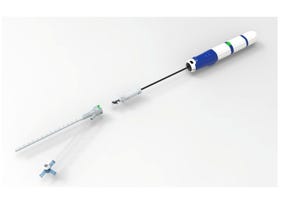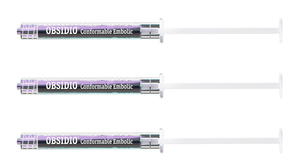The adhesives used in balloon catheter assembly operations must display a range of properties, including, durability and expandability.
January 26, 2015
Adhesives and glues are such common fixtures of everyday life that we tend to take them for granted. But in the medical device world, they must exhibit a precise range of physical and chemical properties while meeting stringent regulatory requirements. Take the case of adhesives used to assemble balloon catheters, for example.
Employed in angioplasty, drug-delivery, and other medical device applications, balloon catheters are used during catheterization procedures to enlarge a narrow opening or passage in the body. Situated at the tip of the catheter, the deflated balloon is inflated during a procedure to perform its function and deflated again when it is removed from the passage. Because they expand and contract, balloon catheters are consequently subject to a range of stresses and elongation requirements, giving rise to the need for assembly adhesives that enable the device to remain intact under pressure.
Flexible but Durable Adhesives
|
The adhesives used to bond balloons to guidewire lumens must be able to securely hold the balloon in place while allowing it to flex and withstand a strong peel force during inflation. |
“The typical balloon catheter consists of a soft, flexible balloon that is bonded to a guidewire lumen,” explains Andy Scott, medical market application engineer at Rocky Hill, CT–based Henkel Corp. “Within the balloon and guidewire, there is an inflation lumen that enables the balloon to be inflated and deflated once it’s positioned or needs to be removed from the body.”
Thus, the adhesives used to bond balloons to guidewire lumens must be able to securely hold the balloon in place while allowing it to flex and withstand a strong peel force during inflation, Scott adds. Once the balloon is inflated, it must be able to hold pressure and withstand the forces that are generated when the catheter is pulled or pushed inside the body. Such adhesives must also be able to undergo stress testing and quality inspection under high-speed production conditions, necessitating formulations that can fluoresce to indicate the position of the bond line.
Usually made of silicone or a form of heavily plasticized PVC to provide comfort for the patient, the guidewire lumen can be soft and flexible or rigid, depending on its use, Scott comments. “There is a common saying that ‘nothing sticks to a silicone but a silicone.’ But because industry-standard silicone adhesives require moisture from the atmosphere to cure and can take anywhere from 7 to 21 days to achieve their full properties, silicone-to-silicone bonding can present a challenge for catheter manufacturers that are trying to mass-produce products quickly.” To overcome this challenge, silicone adhesives have been developed that cure when exposed to the appropriate wavelength of light. This cure process, Scott says, can shorten the manufacturing process from days or weeks to seconds or minutes.
To meet all of these requirements, Henkel offers flexible instant adhesives, visible-light acrylics, and light-curing cyanoacrylates specifically for catheter assembly. Developed for bonding typical catheter materials such as PVC, polyurethane, polycarbonate, stainless steel, as well as specialty metals and thermoplastics, these ISO 10993–certified adhesives produce the types of flexible bond joints that are critical for catheter applications. In addition, they cure rapidly, allow for on-part detection, and create hermetic seals.
Single-Component Adhesives
|
A balloon catheter from Interface Catheter Solutions is assembled using a Cyberbond adhesive. (Photo courtesy of Interface Catheter Solutions.) |
For balloon catheter designs, single-component adhesives offer a range of suitable properties that help to ensure device integrity. “Single-component adhesives are fast-fixturing, fast-curing adhesives that offer low to no stress because they are not solvent-based,” remarks Jonathon Smith, medical device specialist at Batavia, IL–based Cyberbond. “Such adhesives, therefore, do not attack the substrate, nor do they require heat, as do thermal bonds that are formed when a material is softened and a weld is formed.” Single-component chemistries are reactive, Smith adds; they themselves are the bond. They also offer flexibility depending on the chemistry and the formulation.
In the process of developing medical device assembly adhesives, Cyberbond concentrates on a range of parameters. “Peel stress,” Smith comments, “is typically the first consideration in designing balloons. How does the manufacturer evaluate peel stress?” Typically, testing is performed using either air or fluid pressure to the bursting point. Depending on the composition and the wall thickness of the balloon, we see different results. The peel stress level is very key for determining the bond.
Another parameter is the expansion of the balloon material. The specifications for this parameter depend on whether the balloon is a noncompliant, semicompliant, or compliant construction. “What do manufacturers look for in terms of expansion?” Smith asks. “We may need to modify the adhesive depending on whether it is required to offer more or less elongation.”
In addition to tailoring an adhesive to accommodate a variety of balloon parameters, manufacturers must also be concerned with the type of surface to which the balloon will be bonded. “Equally important for consideration,” Smith notes, “is the substrate composition. Traditional materials, such as PET and nylon, are still very common in balloon manufacturing, especially for noncompliant dilation balloons and semicompliant balloons. In addition, substrate materials may also undergo surface treatments to achieve such properties as lubricity or to incorporate antibacterial or drug agents. In essence, if these coatings are applied to the balloon prior to bonding, then that’s what we’re bonding to.”
Manufacturers, according to Smith, are concerned with the physical properties of the surface, regardless of the material from which it is made. They are also concerned with the material’s Dyne level, or surface energy. Cyberbond’s chemistries fall in the range of approximately 34 millinewtons per meter. Optimal bonds happen at Dyne levels above that. But often, materials such as polyolefins fall below that level. In such cases, the surface can be modified to aid adhesion.
“Our adhesives are very application-specific,” Smith says. “Just about everything that we provide for medical device assembly operations is customized in some way, whether it be the formulation or the suggested application and technique.” One reason for customization today, Smith adds, is that the medical device industry is transitioning away from the use of phthalate-based plasticizers. Moreover, the materials that are being bonded to each other are constantly evolving “Thus, we are here not to hinder the advancement of medical devices but rather to respond to what the device manufacturers—particularly catheter balloon manufacturers—are asking for us to bond.” —Bob Michaels
To learn more about medical device assembly adhesives, visit both Henkel Corp. (Booth #2326) and Cyberbond (Booth #1271) at MD&M West, February 10–12 at the Anaheim Convention Center in Anaheim, CA. |
Bob Michaels is senior technical editor at UBM Canon.
You May Also Like




